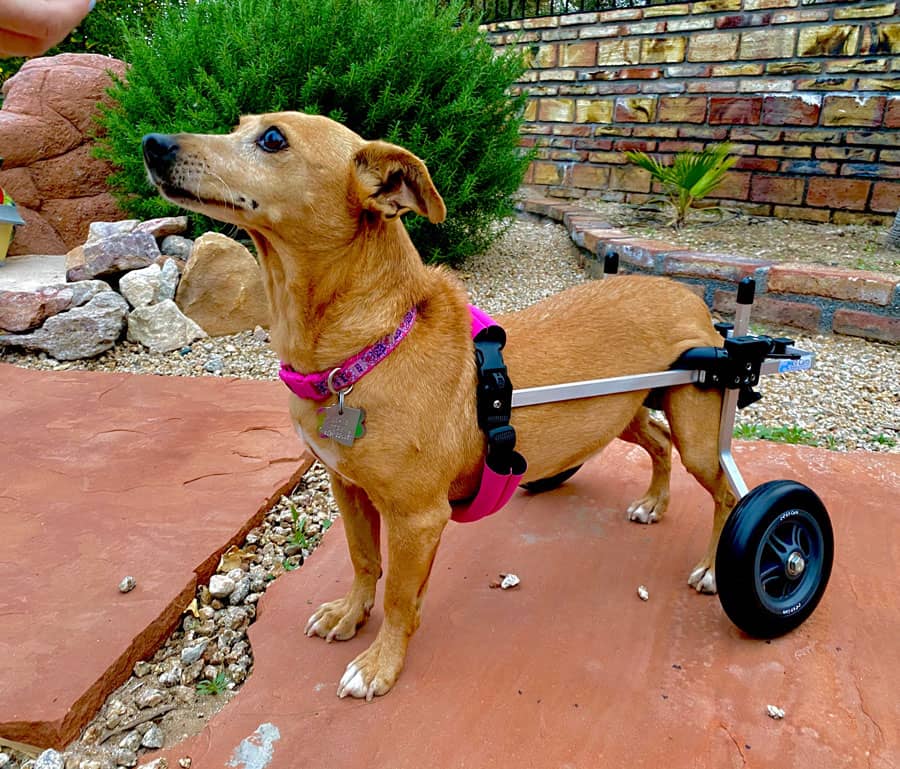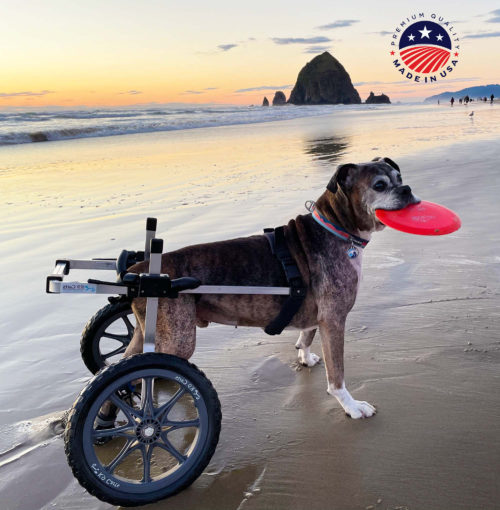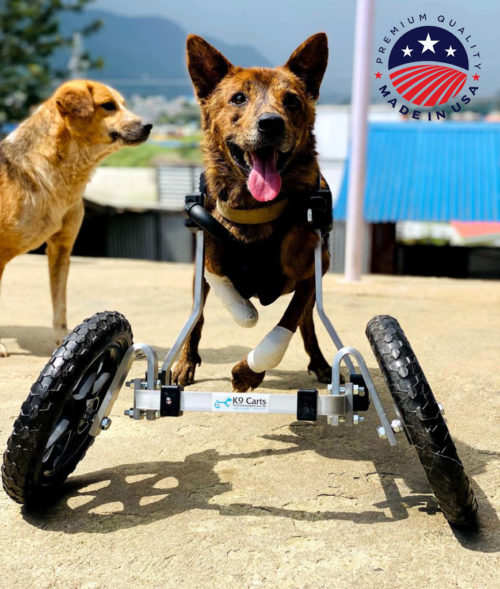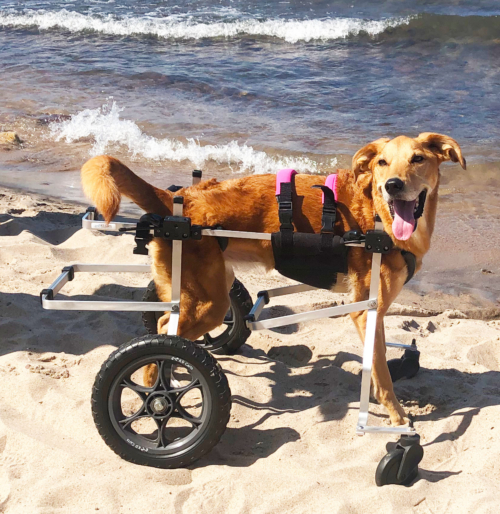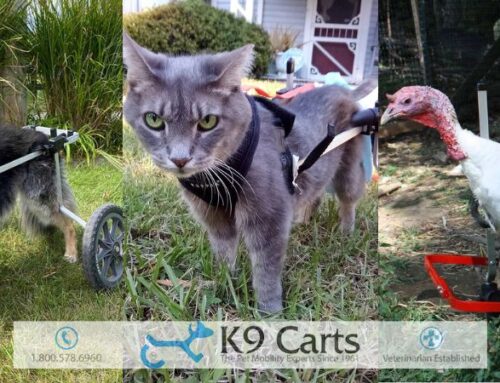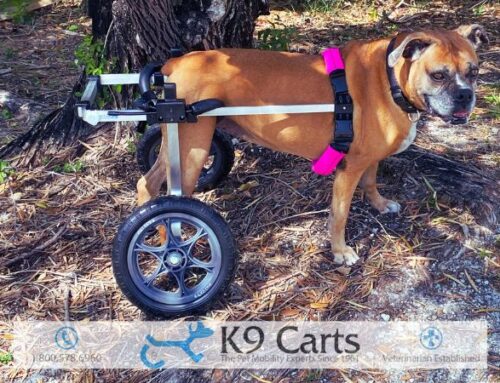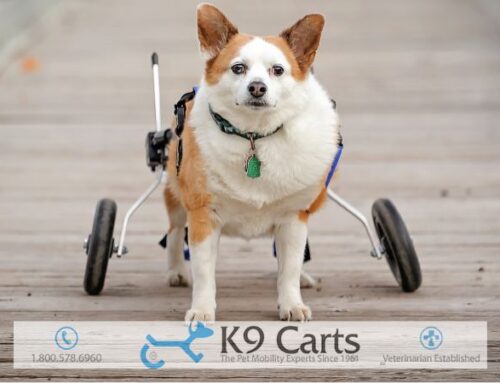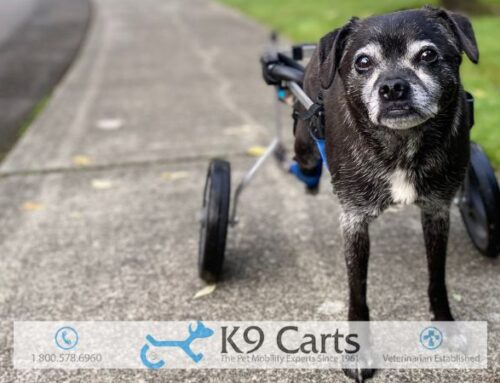When your beloved dog’s hind legs just don’t seem to work properly, both you and your pet may feel considerable distress. Few sights cause owners more sorrow than seeing their best friend hobbling stiffly or wobbling while standing due to a serious injury, congenital defect, or age-related health problem. In addition to the pain that they may cause, unstable or weak hind legs can also make your dog more vulnerable to accidents.
Fortunately, modern medicine and assistive technology can help your struggling friend overcome his limitations. Let’s take a look at some of the problems that can affect a dog’s hind legs, how those problems affect comfort and mobility, and how the right corrective measures can restore your dog’s quality of life.
Causes of Hind Leg Weakness in Dogs
Canine anatomy may differ from human anatomy, but it shares some important basic similarities. A dog may sustain many of the same kinds of hip, knee, or neurological ailments and injuries as humans. These problems may afflict any or all of the animal’s four legs. Hind leg issues can make walking, running, or climbing either extraordinarily painful or completely impossible. Here are some possible causes of hind leg problems in canines.
1. Arthritis
Arthritis afflicts dogs just as it does humans. In the most common form of this inflammatory disorder, osteoarthritis, the joints lose their ability to lubricate their components even as the cartilage between bone ends starts to disintegrate. These changes result in painful joint friction whenever the dog tries to move his hip, knee, or ankle.
Your dog may respond by avoiding stairs or walks, adopting an odd “bunny hop” gait to compensate for a painful joint, or begin developing unusually large front-leg muscles as he relies more and more on these extremities to get around. To learn how to better manage canine arthritis, we recommend reading our essential guide on how to help a dog with arthritis.
2. Hip Dysplasia
Hip dysplasia most frequently occurs in larger breeds such as German Shepherd Dogs, Labrador Retrievers, Saint Bernards and Great Danes. But while size and weight (along with work-related joint overuse) can certainly aggravate the condition, genetic predisposition appears to be the primary factor. Puppies born with this condition have looser-than-normal hip joints. This looseness promotes instability and unnatural wear and tear as the animal grows, often producing osteoarthritis as a complication.
3. Spinal Cord Injuries
A serious injury to the spinal cord can interrupt the normal flow of signals from the spine to the hind legs. This may cause total paralysis, making it impossible for your pet to operate his hind legs at all. A less severe spinal injury may cause partial paralysis, leaving the hind legs noticeably weak and wobbly. The instability grows worse as muscles atrophy due to non-use.
4. Degenerative Vertebral Conditions
Sometimes nerve signals to a dog’s hind legs become partly scrambled due to compression from a neighboring structure. For example, a herniated disc can press against nerve tissue until the nerve tissue cannot conduct signals normally. Unusually long-bodied dogs who carry their bodies low to the ground, such as Basset Hounds and Dachshunds, often suffer from vertebral problems of this nature. A musculoskeletal problem may also create pain or numbness in the legs, making your dog less willing or able to walk.
5. Canine Degenerative Myelopathy
The nerves that control a dog’s hind leg function and sensation can occasionally develop diseases and dysfunctions of their own. One such disease, canine degenerative myelopathy, affects many breeds but occurs most frequently in Boxers, German Shepherd Dogs, Cardigan Welsh Corgis and Rhodesian Ridgebacks. The nerve sheath that insulates the spinal cord’s nerve cells deteriorates, resulting in loss of nerve function. (A similar development in humans takes the form of amyotrophic lateral sclerosis, or ALS.) Dogs with this condition may display signs of tremors in their hind legs, or stand with their hind legs close together and their feet at unusual angles.
6. Amputation
A dog can often adapt surprisingly quickly and easily to the loss of a hind limb, learning how to walk and balance himself with his other three limbs. In some cases, however, the remaining hind leg may suffer from a painful degenerative disease or other condition that makes mobility impossible. A serious injury might even require the amputation of both hind legs, leaving the dog with no way of supporting the rear half of his body.
7. Post-Operative Limitations
Many surgeries to repair or replace damaged hind leg components can restore full mobility to the limb, but not immediately. Dogs recovering from such surgeries may experience temporary disability, with owners instructed to keep their pets from bearing weight on an extremity that has yet to heal.
Treatment Options for Hind Leg Weakness
If your dog has developed increasing difficulty using his back legs to stand and walk, sit, lie down, and climb, you may find the solutions to this problem at your local veterinarian. An evaluation can detect the underlying cause, allowing the vet to suggest numerous possible remedies.
The severity of a hind leg condition may dictate the kind of treatment your pet receives. For example, mild osteoarthritis often responds well to a combination of medication, light exercise, and dietary modifications to promote weight loss or reduce inflammation. Severe degeneration due to arthritis and/or dysplasia may require joint surgery or even joint replacement.
Veterinarians can treat hip dysplasia through surgery. Young dogs can receive a double or triple pelvic osteotomy, which rotates the joint components to improve function. A femoral head osteotomy removes the head of the femur, allowing scar tissue to replace it. Your dog may walk with a limp afterward, but he will no longer be in pain. A total hip replacement can restore both full hip function and full comfort in many canine patients.
Spinal treatments may help some kinds of neurological dysfunction. Your dog might benefit from herniated disc removal and spinal fusion surgery, or from strong anti-inflammatory drugs to reduce swollen tissues that pinch nerves.
When Medical Care Isn’t Enough: Support and Mobility Products
If veterinary medicine can’t resolve your pet’s hind leg issues, look into assistive devices. K9 Carts offers mobility products to help dogs get around easily even if they have painful hind limb problems, limited hind limb function, or no hind limb function at all. Here are two popular options to consider:
Dog Lift Harness
A dog lift harness allows you to provide some gentle support for your pet’s hindquarters, taking stress off of weakened legs or painful joints. Simply put the comfortable foam harness around your dog’s hips and then use the attached cable to lift upward slightly as your dog stands and walks.
Dog lift harnesses can prove ideal for pets who struggle with arthritis, dysplasia, or another painful condition without having lost all of their weight-bearing ability or mobility. These handy devices can make all the difference between having to carry your pet everywhere to letting him roam freely under his own power.
Dog Wheelchair to Support Weak Hind Legs
If your dog cannot bear any weight on his hind legs at all, consider getting a rear support dog wheelchair. These lightweight wheelchairs assume all the weight of your pet’s rear body and do all the work that the hind legs would do. As long as your pet still has comfortable use of his forelimbs, he can move speedily, safely, and confidently with the aid of his wheelchair.
A rear support dog wheelchair makes sense when your pet needs to avoid all weight bearing activities, or when your pet has lost all hind leg function due to a neurological problem. It’s also ideal for amputee pets. You simply need to specify the nature and extent of your pet’s hind leg amputation before purchasing your wheelchair.
To learn more about our custom-built wheelchairs for dogs, please visit the following pages:
Looking to Restore Your Pet’s Comfortable Mobility? Contact Us
K9 Carts looks forward to helping you help your dog. Contact us today to discuss his hind leg issues with us. We’ll be more than happy to answer all your questions and guide you toward the ideal product for your pet’s mobility challenges.


